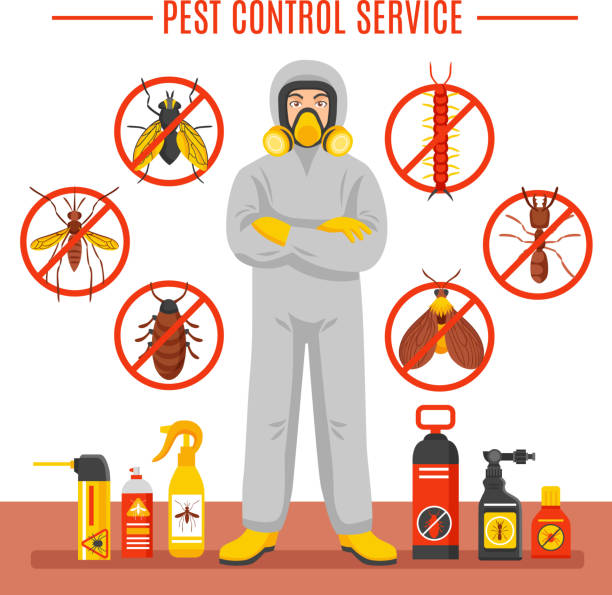Reduce infestations with expert Pest Control strategies that offer long-term results.
Eco-Friendly Parasite Control Approaches for Managing Wildlife in Urban Locations
Urban locations frequently locate themselves at the intersection of human activity and wild animals, bring about distinct difficulties in parasite administration. Green approaches highlight lasting conjunction, using techniques such as habitat adjustment and all-natural repellents to minimize human-wildlife problems. These strategies not only protect the setting yet also enhance community engagement in wildlife monitoring. As city populaces proceed to expand, recognizing the characteristics of wildlife interactions becomes increasingly important. What ingenious techniques can be carried out to make certain both eco-friendly equilibrium and metropolitan safety? Exploring this question reveals an engaging landscape of prospective remedies.
Comprehending Urban Wild Animals Dynamics
Recognizing Urban Wild animals Dynamics is essential for creating efficient and environmentally friendly parasite control methods. Urban areas are significantly ending up being habitats for different wild animals types, driven by variables such as habitat fragmentation, food schedule, and human infringement. Identifying these dynamics enables for a nuanced method to pest monitoring that lines up with eco-friendly principles.
Urban wild animals typically consists of species such as raccoons, squirrels, and birds, which adjust to city environments, discovering particular niches in eco-friendly rooms, parks, and also property locations. Their presence can cause conflicts with people, specifically when they exploit human resources for food and shelter. Recognizing the behaviors and environmental duties of these varieties educates techniques that decrease negative communications while advertising biodiversity.
In addition, recognizing the interdependencies within metropolitan communities assists in determining critical locations for habitat conservation and reconstruction. This expertise adds to the advancement of incorporated bug administration (IPM) techniques that take into consideration the eco-friendly equilibrium, consequently decreasing dependence on dangerous chemicals. By cultivating conjunction between people and city wild animals, cities can create much healthier environments that profit both locals and local communities, leading the way for sustainable city living.
All-natural Repellents and Deterrents
Natural repellents and deterrents supply a lasting option to standard bug control approaches by using the power of nature to keep unwanted species at bay. These green services typically utilize plant-based ingredients, crucial oils, and various other normally taking place materials that deter bugs without hurting the setting.
One efficient all-natural repellent is peppermint oil, which is understood to ward off rodents and insects. Its solid aroma is unpleasant to lots of insects, making it a prominent selection for urban settings. Vinegar and citrus peels can offer as deterrents, as their solid smells are typically uninviting to numerous wildlife.
Additionally, diatomaceous planet is a natural powder that can be spread out in locations vulnerable to parasite activity, efficiently dehydrating and deterring pests without posing threats to non-target types. Garlic sprays and neem oil are acknowledged for their capability to ward off a vast array of parasites, including both insects and larger wild animals.
Carrying out these all-natural repellents not only lowers reliance on chemical pesticides yet also promotes a much healthier metropolitan environment, promoting a much more well balanced conjunction between humans and wildlife. By utilizing these strategies, metropolitan locations can effectively handle pest populaces while lessening environmental effect.
Habitat Modification Methods
Reliable environment adjustment methods play a critical duty in lasting insect management by changing the atmosphere to make it less for pest problems. By recognizing the eco-friendly characteristics of city areas, homeowner can implement tactical alterations that deter bugs while promoting biodiversity.
(Termite treatment Port Charlotte)One key method entails keeping proper cleanliness. This consists of normal waste elimination, protecting trash can, and eliminating standing water to minimize breeding websites for insects and rodents. Furthermore, landscape design techniques such as choosing native plants can boost eco-friendly balance, supplying environments for useful microorganisms while reducing sources for insects.
Another crucial method is to secure access factors in structures. Evaluating and fixing cracks in foundations, walls, and home windows can considerably minimize parasite accessibility. Producing physical barriers, such as fences or plant barriers, can hinder wildlife movement right into human-inhabited locations.
Integrated Bug Administration Practices
Building upon habitat alteration techniques, incorporated insect monitoring (IPM) methods provide a holistic technique to controlling parasite populations while lessening environmental effect. IPM combines different strategies, including organic, cultural, mechanical, and chemical controls, to achieve reliable bug administration.
Biological control includes the introduction of natural killers or parasites to reduce insect populations. Cultural techniques, such as crop rotation and hygiene, disrupt pest life cycles and decrease their environments - Pest control service. Mechanical controls, like traps and barriers, supply prompt remedy for insect stress without chemical treatment
Chemical controls are used as a last resource, concentrating on targeted applications that restrict harm to non-target species and the atmosphere. The choice of eco-friendly pesticides, when required, is important to the IPM structure. In addition, keeping track of bug populations and analyzing potential damage helps inform decision-making, guaranteeing that interventions are timely and efficient.
Neighborhood Involvement and Education And Learning

(Wasp removal Port Charlotte)Workshops and informative sessions can furnish citizens with knowledge about native species, habitat preservation, and reliable safe bug monitoring techniques. Cooperation with colleges, regional organizations, and government agencies better improves instructional outreach, making certain that essential details gets Lawn pest control Port Charlotte to diverse audiences.
In addition, community-led efforts, such as community clean-up days and habitat reconstruction jobs, not only advertise biodiversity yet likewise reinforce neighborhood ties. Pest control service. By motivating locals to share their experiences and monitorings, areas can establish targeted techniques that deal with specific regional pest problems
Incorporating responses from citizens right into insect management intends enables a more receptive and adaptive approach to wild animals difficulties. Inevitably, notified and involved neighborhoods are vital to accomplishing long-lasting success in environment-friendly pest control, causing healthier metropolitan settings that appreciate both human and eco-friendly demands.

Final Thought
In final thought, environmentally friendly pest control comes close to deal sustainable solutions for taking care of city wildlife. By prioritizing environment adjustment, using natural repellents, and implementing incorporated insect management techniques, neighborhoods can foster an unified conjunction with regional animals.